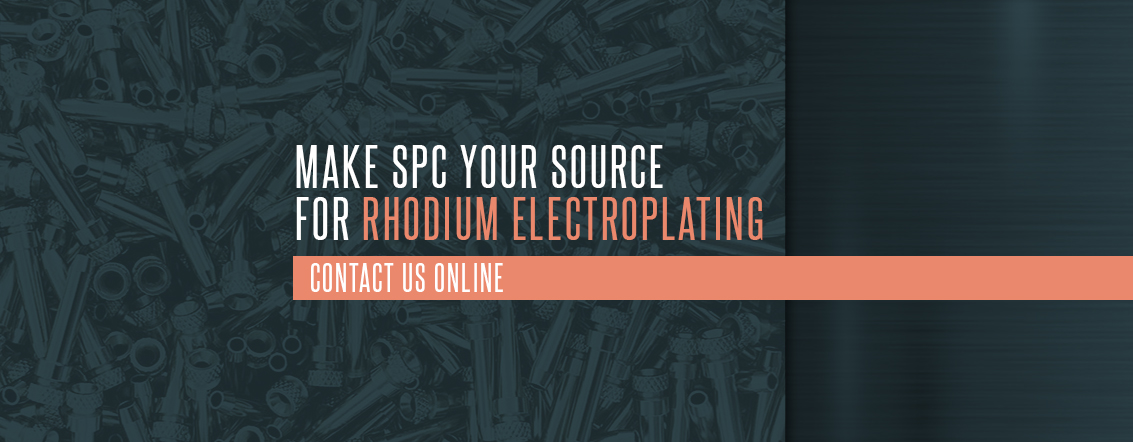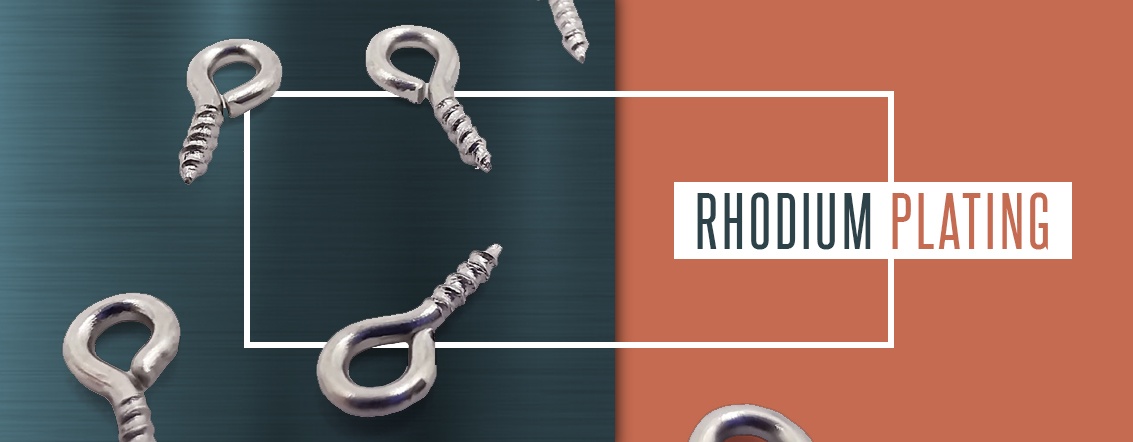
Rhodium Plating
When choosing a metal for plating, rhodium offers many benefits, including durability, electrical conductivity and resistance to heat, wear and corrosion. These attributes make this metal a prime choice for plating while saving the cost of using rhodium for the entire construction of a part. Since the cost to use precious metals like rhodium for plating may be higher compared to using other metals, you must understand why rhodium is the best choice for your application. In many instances, its positive attributes make it a preferred choice for plating.
Quick Links
Rhodium Plating Methods | Rhodium Plating Specifications
Make SPC Your Source for Rhodium Electroplating
Rhodium Plating Capabilities
- Type 1
- Type 2
Rhodium Plating Methods
Rhodium Plating Specifications
When plating for military applications, MIL-R-46085B comes into consideration. This military specification for plating governs how you use rhodium for plating onto base metals. Included in this spec are two types of coating:
- Type 1: Use this over gold, silver, platinum or nickel.
- Type 2: This form of rhodium coating requires a nickel undercoat when plating onto base metals other than those listed for Type 1 plating.
Classifications of plating with this metal depend on the thickness of the coating:
- Class 1: 0.05 micrometers (0.000002 inches) thick
- Class 2: 0.25 micrometers (0.00001 inches) thick
- Class 3: 0.51 micrometers (0.00002 inches) thick
- Class 4: 2.5 micrometers (0.0001 inches) thick
- Class 5: 6.4 micrometers (0.00025 inches) thick
Rhodium Plating FAQs
By addressing your concerns about the process of obtaining a rhodium plate, these questions will help you to decide if this alloy is the best option for your application.
1. What Is Rhodium?
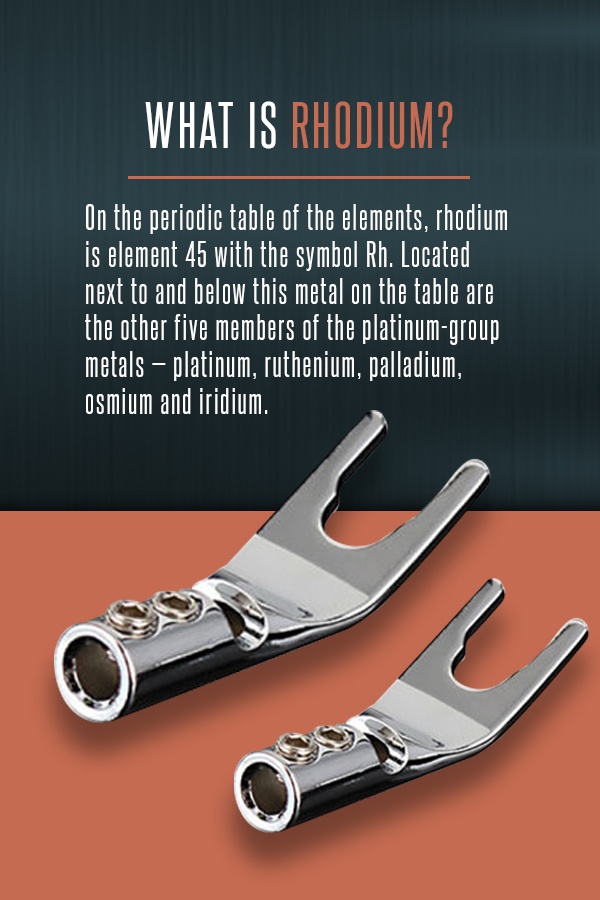
On the periodic table of the elements, rhodium is element 45 with the symbol Rh. Located next to and below this metal on the table are the other five members of the platinum-group metals — platinum, ruthenium, palladium, osmium and iridium. These and other noble metals are known for their superior resistance to oxidation and corrosion, even when exposed to extreme moisture.
Due to its extreme rarity, aesthetically pleasing silvery-white color and numerous positive attributes, rhodium also falls under the precious metals category. Like other precious metals, pure rhodium has uses in many industries that take advantage of its benefits beyond the aesthetic, such as its conductivity, durability, hardness and corrosion resistance.
2. What Are Its Characteristics?
The characteristics of this metal mirror some of those of others in the platinum group. Rhodium's attributes include:
- Superior hardness
- Inability to oxidize with a typical rate of +3 and rates of +6 possible
- High density allowing thick coatings in electroplating
- A high melting point for extreme temperature applications
- Acid resistance
3. What Is the History of This Metal?
William Hyde Wollaston discovered rhodium in the early 19th century, shortly after his discovery of palladium. Initially, few applications for this metal existed, though. Due to its heat resistance, one of its few uses shortly after its discovery was as a component of thermocouples to assist in the measurement of high temperatures.
As with most precious metals, rhodium serves a decorative purpose as a finish on various consumer goods. However, a more practical use emerged in the automotive industry with the invention of the three-way catalytic converter in the 1970s. This device controls emissions as part of a vehicle's exhaust system. While older models of these units primarily used palladium or platinum, the three-way versions can use the less expensive rhodium. This innovation increased demand for this metal. Rhodium remains an important resource for the automotive industry today.
4. Where Does Rhodoum Come From?
The world's top exporter of rhodium is, by far, South Africa, followed by the United Kingdom, China, Germany and the United States. Rhodium is difficult to obtain since most producers cannot find it in a readily useable form. Rhodium more often is a byproduct of nickel and copper refining processes.
5. What Does Rhodium Electroplating Involve?
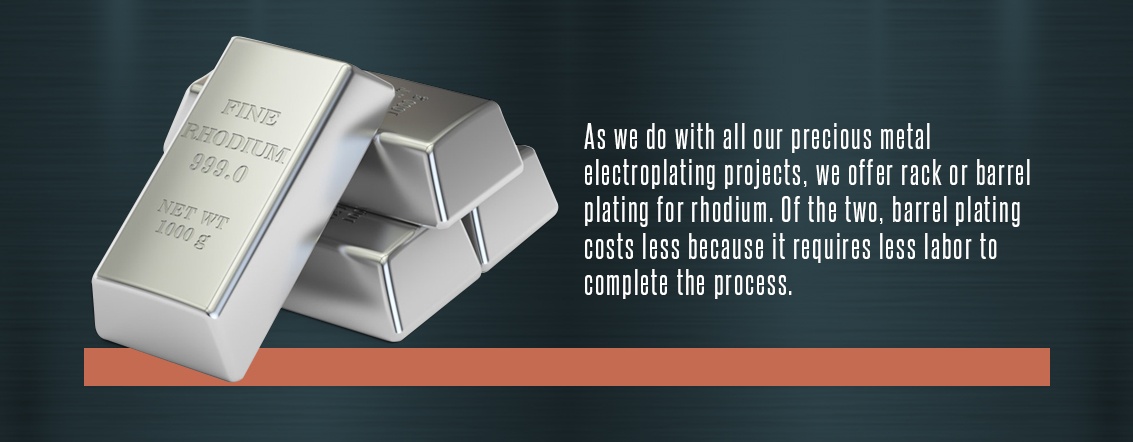
As we do with all our precious metal electroplating projects, we offer rack or barrel plating for rhodium. Of the two, barrel plating costs less because it requires less labor to complete the process. Barrel electroplating provides an even coating for small pieces that tumble through a barrel with the solution in it. This process does not accommodate large or delicate parts, though.
For such pieces that need electroplating, choose our rack method. Before the process begins, we affix each individual piece to a rack to hold it firmly in place throughout the process. This option works very well with larger parts or those that would suffer damage from the barrel method. Due to the added labor of putting all the parts into the rack properly, rack plating has a higher cost than the barrel method.
Aside from the differences in whether we fix the pieces into place or not, the plating process is similar for both barrel and rack plating.
Request a free quote
For Rhodium Coating
6. What Is the Plating Process?
At SPC, we have perfected a multi-step electroplating process that produces consistent results. It is through our preparation and process that we achieve such reliable outcomes. Improper cleaning and poor preparation create several problems during the electroplating process, so we prioritize avoiding these issues. The SPC team uses the following steps in our electroplating process:
- Polishing the piece to achieve a bright finish
- Completing ultrasonic washing to remove stubborn contaminants such as grease and oil
- Rinsing the object with distilled water
- Steam cleaning to remove additional impurities from the surface of the piece
- Electro cleaning in a bath consisting of a special acid and distilled water. We add a positive electric charge to the bath using a transformer. We then attach a negative lead to the object.
- Rinsing the object again in fresh, distilled water
- Dipping the object into a room temperature rhodium solution for plating. The bath receives a positive electrical charge, while the plated item receives a negative charge
- Rinsing the plated piece in clean, distilled water
- Steam cleaning the piece to remove any residue
- Heat drying the piece with a blow dryer
The actual electroplating process takes less than a minute, but the preparation requires much more time. Because we don't cut corners with preparation, we can achieve ideal results in most instances.
7. What’s the Cost of Plating With Rhodium?
The cost of rhodium plating depends on several factors. As a precious metal, it has a higher cost compared to other coatings. However, few alternatives impart the same benefits that this metal does.
Your project's total cost depends on multiple aspects of the process, including whether you choose rack or barrel electroplating, the thickness of the coating you require, whether you need Type 1 or Type 2 coating, the size of your project and if you need any additional services.
8. What Are the Benefits?
The rhodium plating process offers several key benefits that can improve the substrate in a number of ways:
Corrosion protection: Rust and corrosion pose a significant threat to many metal products. According to ASMInternational.org, there are five common methods for effectively controlling corrosion in metals:
- Material selection
- Inhibitors
- Cathodic protection
- Design
- Coatings
The "coatings" method includes the use of electroplating to apply a corrosion-resistant finish onto the surface of a metal substrate. A noble metal, such as rhodium, will significantly enhance the workpiece’s ability to fend off corrosion and lengthen the product’s lifespan.
- Wear and abrasion resistance: Electroplated rhodium features a hardness ranging from 400-550 on the Vickers hardness scale. Because of this extreme hardness, rhodium offers excellent protection against premature wear and can prevent the occurrence of incidental abrasions that can detract from the substrate’s appearance.
- Enhanced durability: A rhodium coating will ensure the longest possible part or device lifespan, even in the most challenging environments.
- Low electrical resistance: Rhodium features the lowest electrical resistance of any of the platinum-group metals, meaning that it readily enables the flow of electric currents. This makes plating with rhodium a good choice for applications that require a high degree of electrical conductivity.
- Low-contact resistance: Rhodium-plated objects are also known for their low and stable contact resistance.
- Chemically inert: This metal is a chemically inert material, meaning it will not react adversely with other metals or chemicals during electroplating.
- Aesthetic appeal: One of the most significant benefits of plating with precious metals is their ability to enhance the appearance of the substrate. Plating with rhodium produces a brilliant finish that is much whiter in color than palladium or even platinum. The coating is also highly reflective, which adds to the brightness and shine of the workpiece.
9. What Are the Potential Drawbacks?
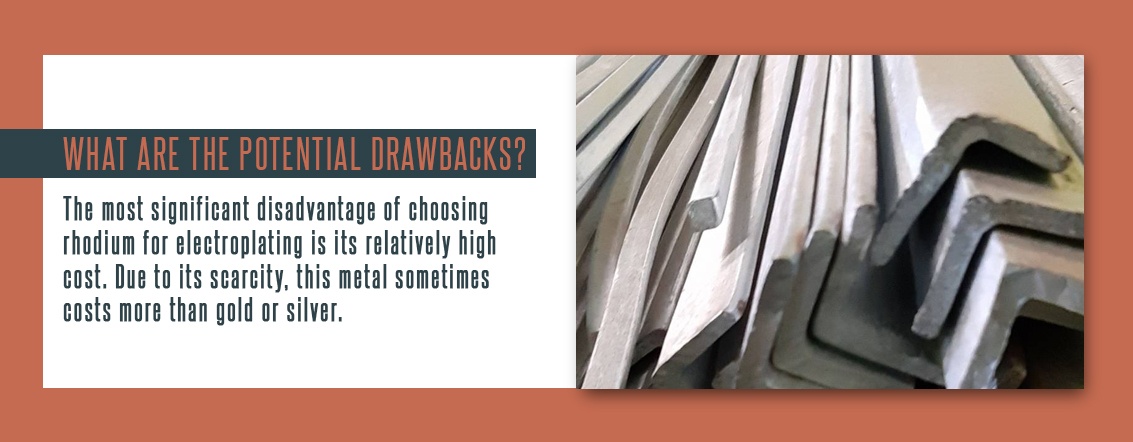
The most significant disadvantage of choosing rhodium for electroplating is its relatively high cost. Due to its scarcity, this metal sometimes costs more than gold or silver. Price can fluctuate substantially throughout the year based on supply and demand.
The second major drawback typically only impacts those looking to use this metal as a decorative coating at low thicknesses. Over time, this thin coating will wear off, but most industrial applications require plating at thicknesses that avoid this problem.
10. What Are the Industrial Applications of Rhodium Plating?
According to the Royal Society of Chemistry, about 80 percent of the rhodium used in industrial applications goes toward the manufacturing of catalytic converters in automobiles. This is due to rhodium’s ability to reduce the level of nitrogen oxides found in exhaust gases.
Another common rhodium application is in the production of nitric and acetic acids, along with its role as a catalyst in various hydrogenation reactions. Rhodium is also used in the manufacturing of optic fibers, optical mirrors and thermocouple elements. Because of its low electrical resistance, rhodium is frequently used as electrical contact material.
Here are several examples of the uses of rhodium plating:
- Alloyed with other platinum-group metals such as palladium and platinum to create a corrosion- and/or heat-resistant coating
- Plating sterling silver to prevent tarnishing
- Manufacturing of detectors used in nuclear reactors to gauge the level of neutron flux
11. What Are the Alternatives to Plating With Rhodium?
Other platinum group metals such as palladium or platinum may stand in for rhodium in some applications. Due to price fluctuations, you may find other precious metals cost less at the time you need the coating. Palladium, platinum or palladium-nickel plating may stand in for rhodium in some applications, including many uses in the electronics industry.
12. What Are Common Rhodium Electroplating Issues?
Typically, rhodium should produce a bright, silvery-white color. However, setting the current in the electroplating bath too high or having contaminants in the bath may cause the coating to appear black. The presence of dark spots is usually an indication that air bubbles are adhering to the mounting. While you may remove these spots through agitation, avoiding them in the first place is a better option. Note that inadequate cleaning before the process will prohibit effective plating under any circumstances.
13. How Do You Troubleshoot These Common Plating Issues?
For best results, plating should occur in an enclosed, clean and properly ventilated environment. Any contamination of the plating bath will negatively affect the final outcome. Insufficient cleaning of the substrate prior to electroplating can produce gas bubbles that cling to the surface. These bubbles may form spotty deposits, marring the appearance of the finished piece.
Cloudy or darkened coatings often come from using excessive voltage levels in the electroplating bath or the presence of contaminants. Reducing the voltage will remedy the first issue. A carbon treatment in the bath should remove any remaining contaminants to solve the second problem.
Coating thickness is another consideration when plating with rhodium. For applications where quality and performance are more important than appearance, we can achieve a coating with a thickness of up to 5.0 microns. However, when we create thicker plating that exceeds 2.0 microns, the coating tends to become brittle and may require additional finishing processes to alleviate deposit stress.
Additionally, it is imperative to closely monitor the plating bath temperature and electrical current from the beginning of the rhodium plating process to the end, as even slight fluctuations can substantially alter plating results.
Finally, we thoroughly rinse and dry all parts after electroplating to stop the process and remove any liquid from the surface.
Make SPC Your Source for Rhodium Electroplating
At SPC, we offer industrial-grade rhodium electroplating for the electronics, telecommunications, automotive and other industries. To fulfill the needs of these sectors, we must consistently produce electroplating that performs reliably in various applications.
Sharretts Plating Company has been a metal finishing innovator since 1925. Over our more than 90 years in business, we have developed and implemented various electroplating techniques that have set the standard for the entire industry. Our capabilities include a highly effective electroplating process that can meet the most complex specifications. We specialize in rack electroplating for large, complex and delicate parts that require careful handling and precise quality control.
SPC is an ISO-certified company that adheres to the highest quality standards in every aspect of our operation. We also work closely with all of our clients to develop and implement a customized electroplating process that helps them meet their most demanding metal finishing challenges. Our full range of rhodium plating services includes prototyping that can provide a cost-effective, task-specific solution that will ensure our clients achieve their production and profitability objectives. Contact us for a free quote to get started with your electroplating project.
Additional Resources:
CONTACT US TO LEARN MORE ABOUT OUR RHODIUM PLATING SERVICES
We invite you to learn more about how the SPC rhodium plating process can benefit your organization. Contact us for additional information about our premium rhodium plating services and to receive a no-obligation quote today!
LEARN WHAT OUR MANY SATISFIED CUSTOMERS HAVE TO SAY ABOUT Us
"I would like to thank you for the help you have provided us in developing an electroless nickel plating technique on an unusual substrate. The sample platings you provided show that we should be able to reach our goals. I especially appreciate your willingness to take on an unusual job, with the uncertainties that that entails...We are looking forward to working with you in the future on our plating needs."
– Robert K.


